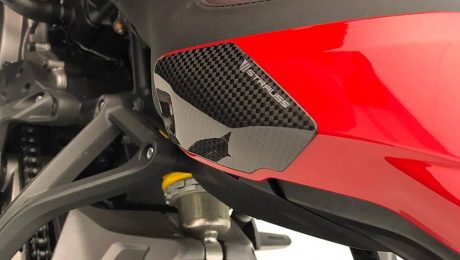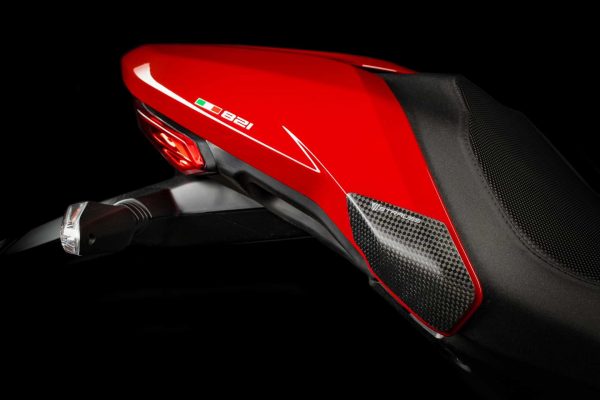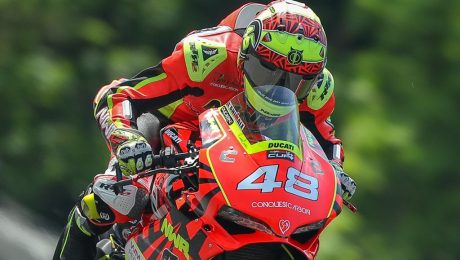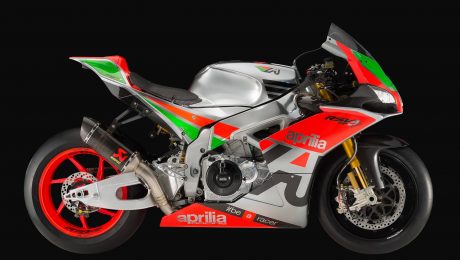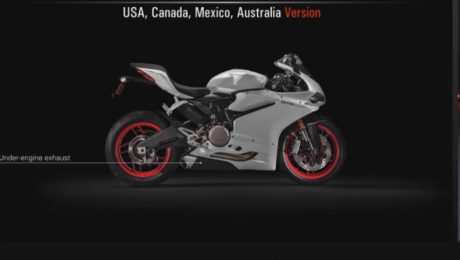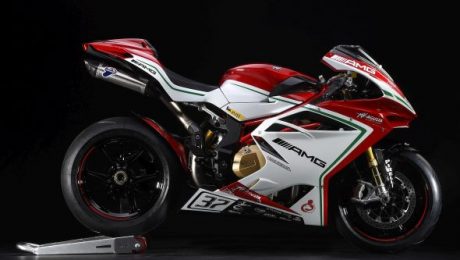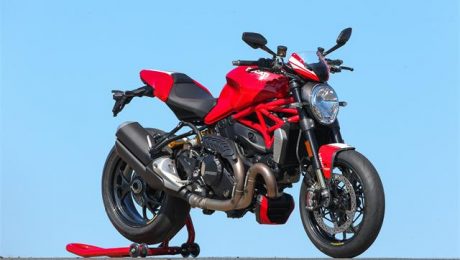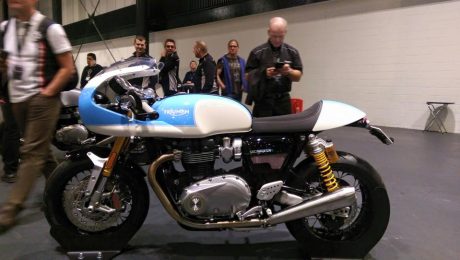Ducati Streetfighter V4 V4S 2020 Specifications
Ducati Streetfighter V4 V4S 2020 Specifications
New Streetfighter V4: The Fight Formula
Ducati Streetfighter V4 V4S 2020 Specifications
Panigale V4 stripped of the fairings, with a high and wide handlebar, 178 Kg powered by 1.100 cc Desmosedici Stradale delivering 208 Hp hold at bay by biplane wings and a complete electronic package.
This is the “Fight Formula”. This is the Streetfighter V4:
Shop now for the latest Ducati Streetfighter V4 V4S performance parts
-
The 2020 Ducati Streetfighter V4 was just launched at the Ducati World Premiere 2019.
-
It has 208 bhp, 122.6 Nm, and weighs only 178 kg dry.
-
There are the standard and “S” models.
The most anticipated bike of the year, the 2020 Ducati Streetfighter V4 was just launched at the Ducati World Premiere 2019.
And as promised by the manufacturer, the bike is a powerhouse that would scare off sportbikes. In case you missed the teaser video, the 1100cc Desmosedici Stradale engine punches out an unholy (for a naked bike) 208 bhp at 12,500 RPM, 122.6 Nm of torque of 11,500 RPM.

If those figures are awesome, think about the weight: 178 kg dry. That gives the bike a 1.17 bhp/kg power-to-weight ratio, which some sportbikes could only envy. As a matter of fact, Ducati aimed for 25% more power over their closest competitor.
However, there’s a Streetfighter V4 S model and it produces 216 bhp!
The full specs are just filtering through at the moment. But among other things is the electronics suite which is shared with the Panigale V4.
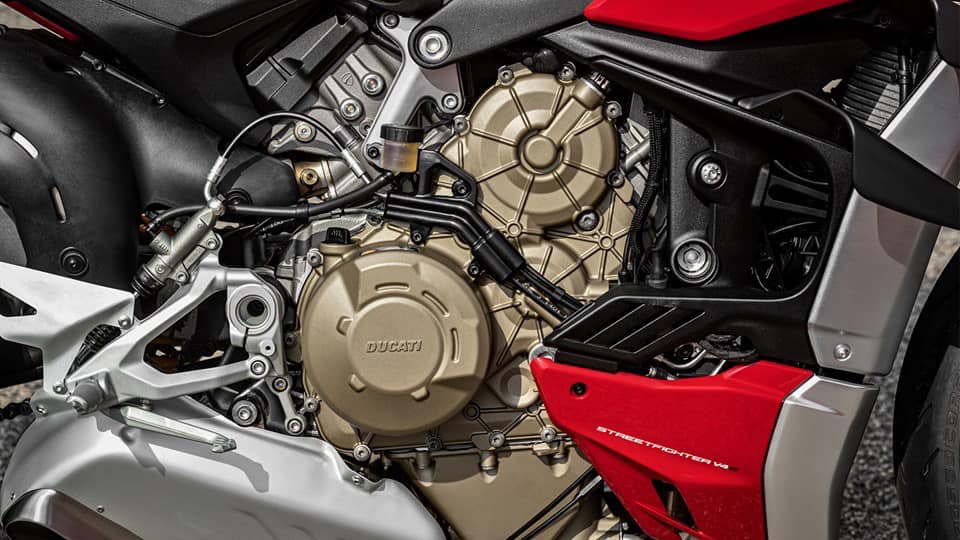
And just like the Panigale V4 S, the Streetfighter V4 S uses the amazing Ohlins Smart EC 2.0 suspension.
But it has something which only the Panigale V4 R has: Winglets. Make that twice the V4 R’s winglets. The Streetfighter has four of them!

Ducati also released the prices. The standard bike costs €19,990 while the “S” is at €22,990.
Stay tuned as we will bring you the full specifications of the bike later.
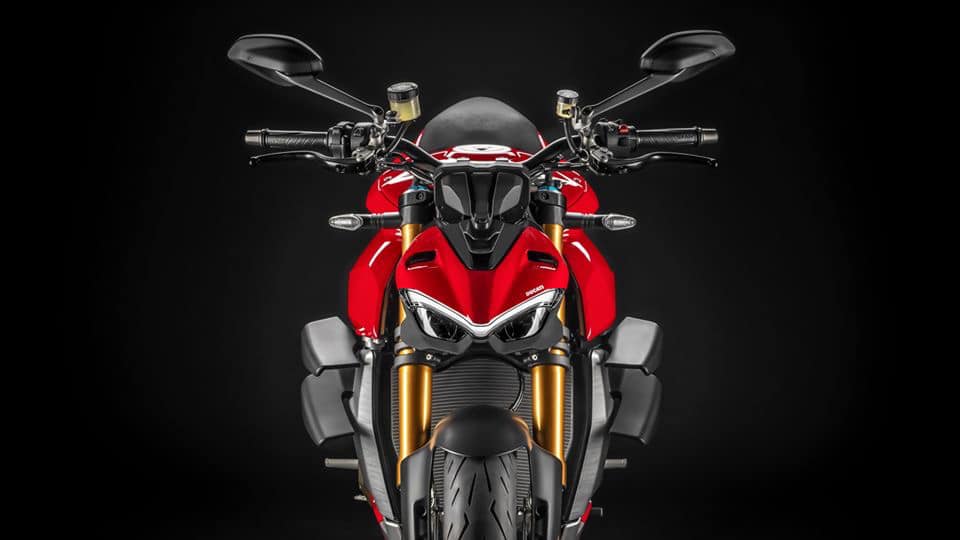
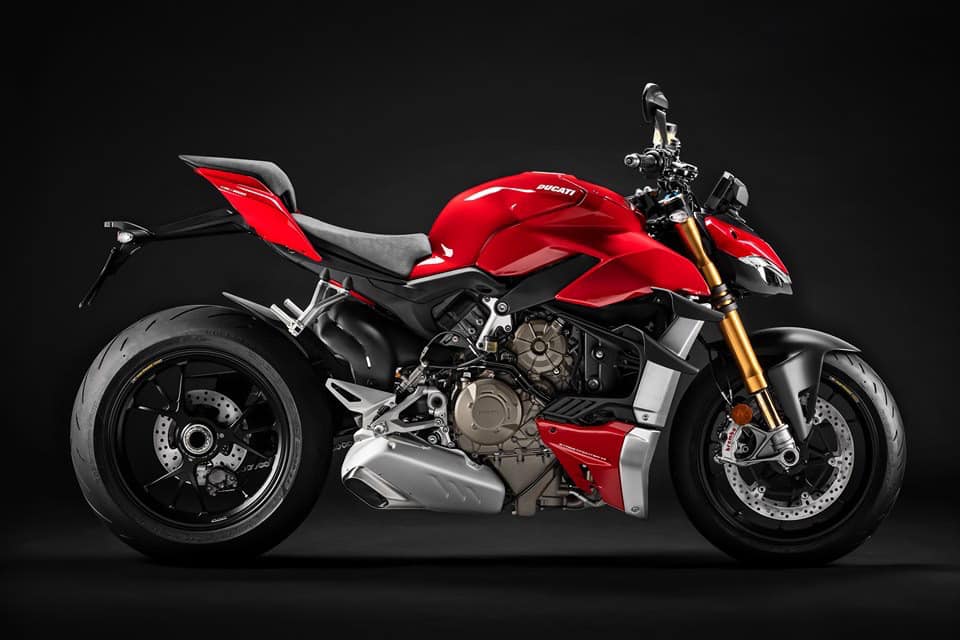
- Published in Motorcycle Review
Conquest Racing – Motorcycle Performance Parts
Conquest Racing – Motorcycle Performance Parts
WELCOME TO CONQUEST RACING LTD

Conquest Racing Ltd – (AKA Conquest Carbon) – was founded back in 2012
Our business has flourished ever since so inevitably a website to sell the inventory was essential. We realised that carbon fibre was a very popular product so we set out to find the best manufacturers to supply our customers.
We have always strived to seek out and acquire the very best motorcycle performance parts that manufacturers in the motorcycle industry can provide, as we see it as our personal mission to be leaders in this vastly competitive marketplace.
Never willing to sit still and relax on our laurels, we have moved on to supplying other high-performance motorcycle parts including CNC parts, race screens, crash protection & performance air filters up to and including performance exhausts for road and race use.
To reflect this expansion of our company’s direction and the huge array of performance parts available for your motorcycles we have decided to change our name to what is now known as CONQUEST RACING LTD.
Wishing you all happy and safe riding.
From us all at Conquest Racing Ltd.
To view, our great products click on the link “SHOP” below
Conquest Racing – Motorcycle Performance Parts
- Published in Motorcycles
2016 Aprilia RSV4 R-FW 230bhp Race Bike
2016 Aprilia RSV4 R-FW 230bhp Race Bike
We knew Aprilia were going to do something awesome with the epic RSV4, in terms of a track-only machine, but we honestly didn’t know just how special it would be…
What was once the preserve of race teams can now be bought by anyone, thanks to Aprilia, and it seems as though they’re catering for many wallet sizes at the same time, albeit still not at the cheap end of the scale! Then again, quality costs.
Prices are yet to be revealed, as are the schemes for adding or removing items to adjust the cost, but we do know there are five models to choose from. And, when it comes to a track only bike, we doubt you’ll find better on offer than any of these!
As Aprilia themselves put it – Aprilia Racing, the Racing Division that has earned the Noale-based manufacturer 54 World Titles, introduced a program today to make the same technology that was developed for the championship winning bike available to anyone who wishes to compete in factory derivative championships or who wants an RSV4 with racetrack optimised performance – meaning they’re there for you to go racing on, or racing your mates on, or just thrapping around a track on and if you’ve got the cash, you can have a track bike that genuinely makes over 210bhp at the rear wheel. Wow…
The five models are as follows:
RSV4 R-FW Stock1 MM Race
An Aprilia RSV4 with Race Pack (Öhlins suspension and forged rims).
Standard electronic system with an extra light lithium battery.
ECU reprogrammed to Race version with race maps for engine and bike management, developed by Aprilia Racing.
Settings reprogrammed for race use.
Braking optimised and weight reduced, ABS removed
Engine weight reduced without the water thermostat, with a simplified water tubes kit and secondary air system closed.
Optional: Akrapovic exhaust kit, complete fairing kit, dedicated suspensions setting and complete engine optimisation.
RSV4 R-FW Stock2 APX Race
An Aprilia RSV4 with Race Pack (Öhlins suspension and forged rims).
Simplified, lightweight, racing version electronic system with dedicated bike and engine wiring and a lithium battery.
APX2 logic unit developed by Aprilia Racing: ignition and engine control parameters may be programmed with the included hand terminal.
Data acquisition system allows logging of original sensors as well as optional sensors allowed by FIM Superstock 1000 rules.
Special Aprilia Racing instruments.
Special engine with Aprilia Racing preparation.
Optional: Akrapovic exhaust kit, complete fairing kit, dedicated suspensions setting.
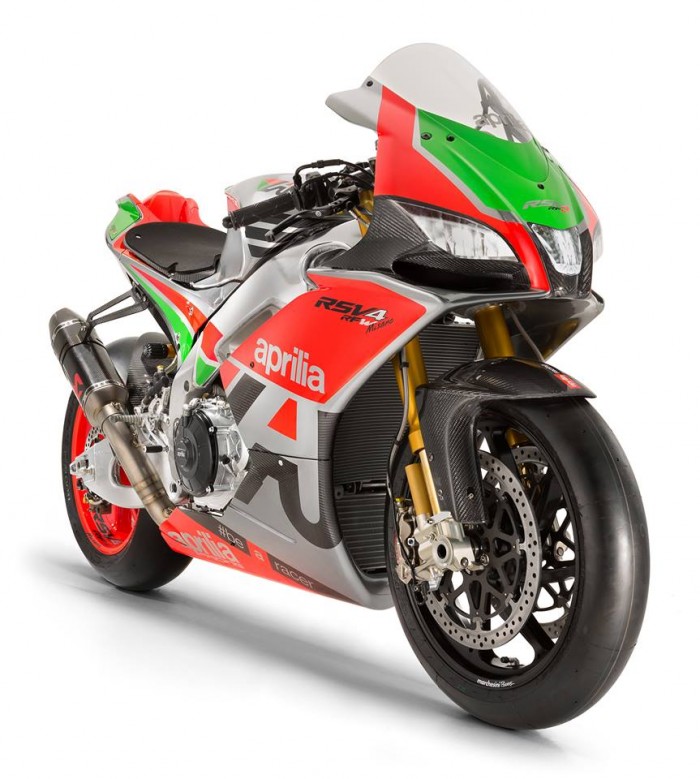
Then it gets really serious…
RSV4 R-FW SBK
An Aprilia RSV4 with Race Pack (Öhlins suspension and forged rims).
Simplified, lightweight, racing version electronic system with dedicated bike and engine wiring and a lithium battery.
APX2 logic unit developed by Aprilia Racing, complete with GPS module, ignition and engine control parameters may be programmed with the included hand terminal. The unit includes a data acquisition system with optional telemetry sensors kit.
Special Aprilia Racing instruments with racing buttons.
Electronic gearbox with assisted shifting (blipper).
Special Aprilia Racing tools.
Special engine with SBK preparation by Aprilia Racing.
RSV4 R-FW W-SBK
Replica of the RSV4 Superbike used by the official Aprilia Racing Team in the SBK Wold Championship.
Both the bike and the level of assistance may be tailor made in accordance with the budget and ambitions of each rider and team.
It is the best that can be desired and allows one to have a star role in the Superbike world championship.
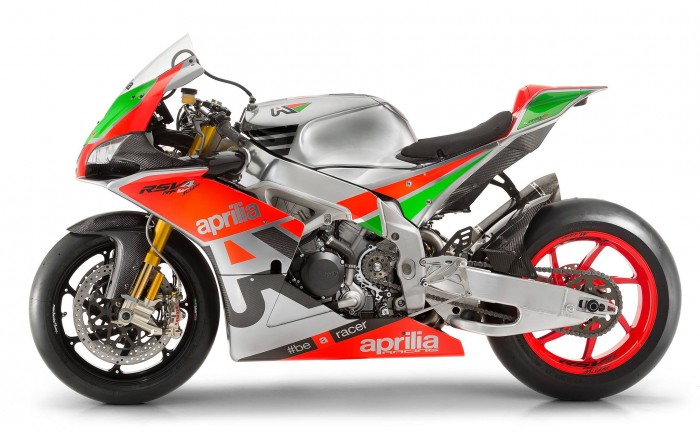
And then, finally…
RSV4 R-FW ‘MISANO’
The bike presented at EICMA is a demonstration of the level of preparation possible through the ‘Factory Works’ program and is the entry level for the W-SBK line.
In true Aprilia Racing style each component has been optimised to offer the best in performance while maintaining elevated overall balance and reliability.
It is a bike that can do well at any competitive level, while remaining “within reach” of enthusiasts who desire an extraordinary bike to exercise their racing skills, knowing that nothing can come closer to the rush felt by SBK World Championship champions.
The colour scheme is a celebration of Aprilia’s first victory in a ‘road racing’ competition and underscores the exclusivity of the model
That is astonishing, although we believe the one most relevant to us normal folks is the first, the Stock1 MM Race. Unless you’re minted, in which case, go nuts!
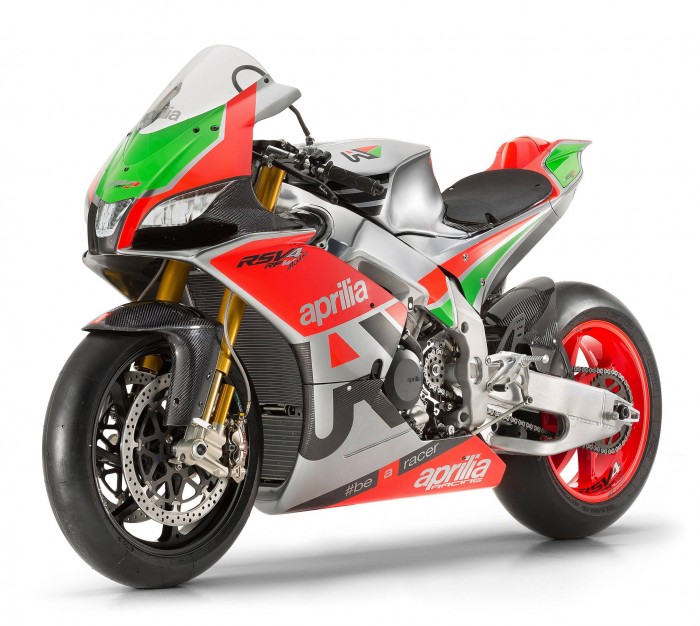
Aprilia’s racing boss also had some words to say about the new program:
Romano Albesiano – “The RSV4 racing versions we are presenting at EICMA are, first and foremost, a unique opportunity that Aprilia Racing is making available to those who want to own a real race bike. At the Aprilia Racing Division we worked to pack all the know-how behind the RSV4 into these exceptional bikes: know-how which has made the RSV4 one of the top winning bikes in the history of production-derived bikes. The SSTK Championship victory this year is an addition to 7 world titles we’ve won in the SBK. Now all the experience we have acquired through these victories is available to whoever wants to race with our bike: both those who want to participate in championships and those who want to ride a real Aprilia Racing bike on the racetrack. We’re making several levels of sophistication available. This is a racetrack optimised RSV4, from the SSTK version (in every way the bike that dominated the Superstock 1000 FIM Cup) all the way to the top, a full-fledged Superbike”.
So, the top spec’ version makes 230bhp at the crank. But as the stock RSV4 RF or RR makes 200bhp at the crank (184bhp rear-wheel on our dyno), you can expect the lower spec’ versions to still be pretty healthy, banging on the door of a genuine 200bhp at the rear wheel on the Superstock model. And that, ladies and germs, is more than enough for most of us bar actual racers.
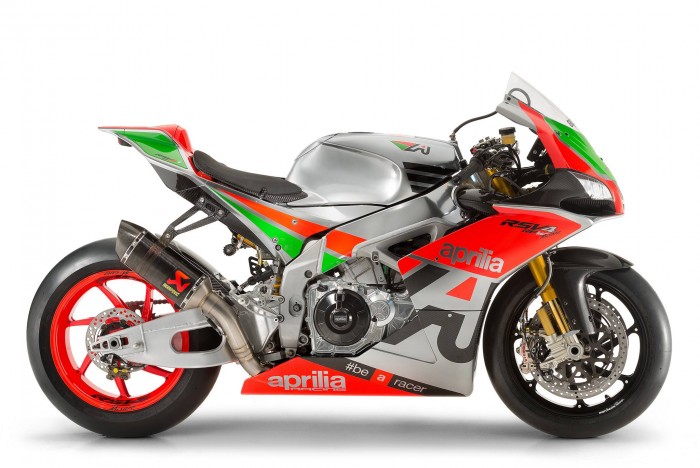
Prices are yet to be confirmed, but as soon as we get them, we’ll let you know.
source:fastbikes
Click here to view Aprilia RSV4 Performance Parts & Carbon Fibre
- Published in Motorcycles
New 2016 Ducati 959 Panigale
New 2016 Ducati 959 Panigale
New 959 Panigale, +6%BHP, +8% torque, 157BHP, 107NM, 1299 fairing side exhaust like on the Japanese Panigale, except for USA, Canada & Australia.
Powered by a revised 955cc Superquadro motor, the 959 punts out a claimed 157bhp at 10,500rpm by lengthening the stroke from 57.2mm to 60.8mm, while the bore remains the same at a nice, round 100mm. Trackdayers and Sunday racers rejoice, as Ducati engineers have also inserted some all-new con-rods to cope with the longer stroke and meatier performance.
Chassis wise, the 959 ‘Gale has a dry weight of 157kg and some wider front fairings. Although the front-end geometry from the 899 remains, the swingarm pivot has been lowered by 4mm (a bit of a surprise) to give a 51%/49% weight distribution in favour of the front.
Back to those exhausts: having seen pandemonium across social media, let’s just put things into perspective. Standard 899s and 1299s have been struggling with noise limits at 99% of circuits in the UK, so the new configuration will undoubtedly do something to remedy Betty and Cyril’s miraculous hearing enhancements and constant moaning.
Other than the aforementioned, that’s about it when it comes to headline aspects. It comes rolling with the usual Panigale electronics suite, sprung by the same Showa/Sachs suspension partnership, and Brembos obviously do the stopping.
TBC but the Ducati 959 Panigale will cost you £13,295.
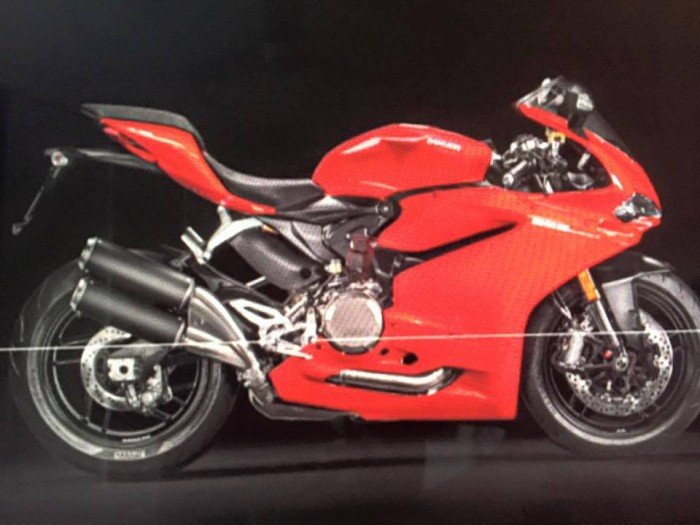
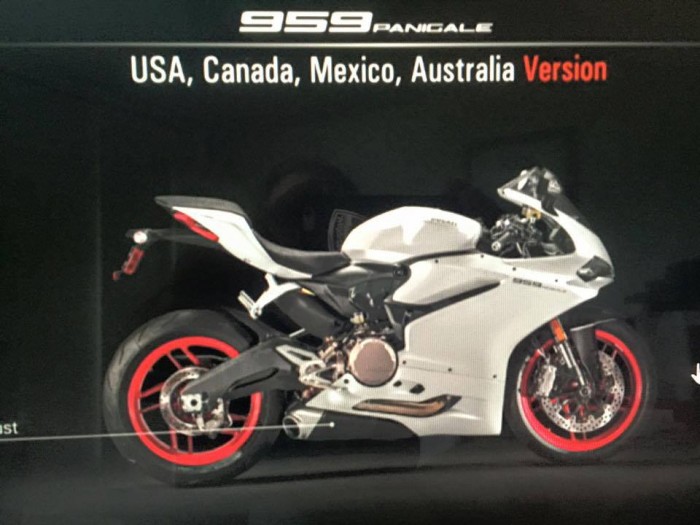
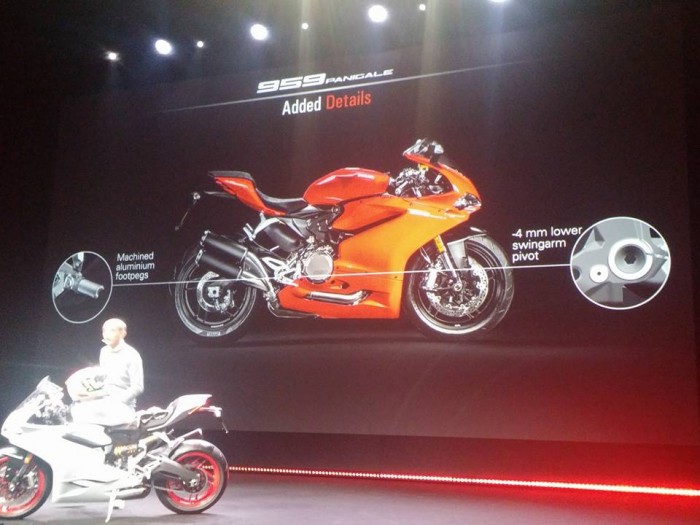
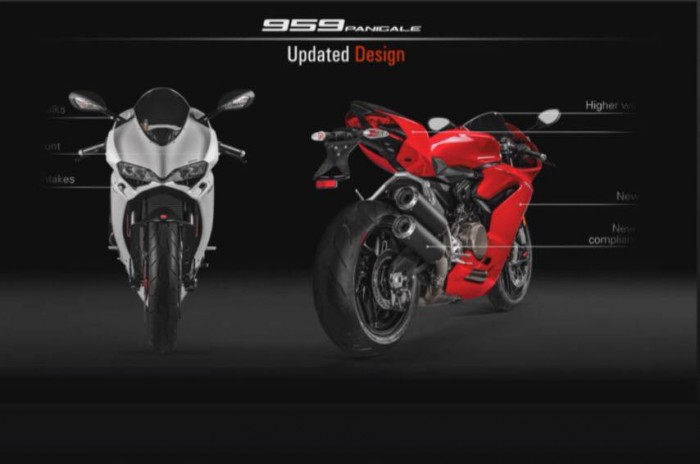
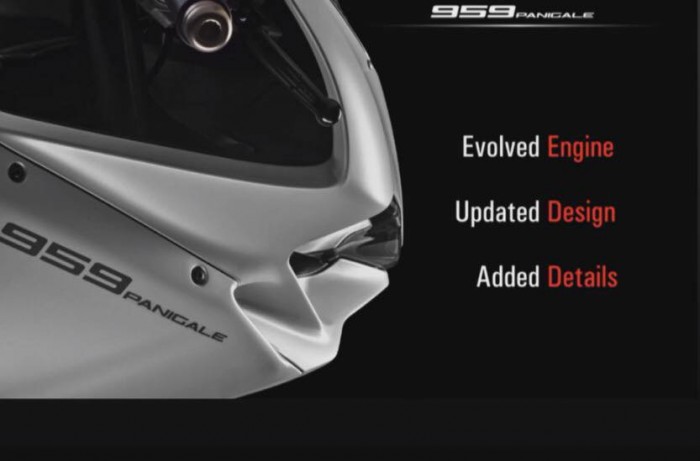
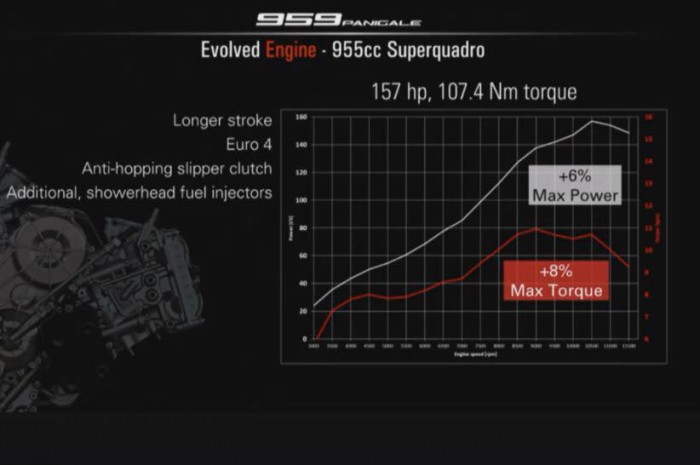
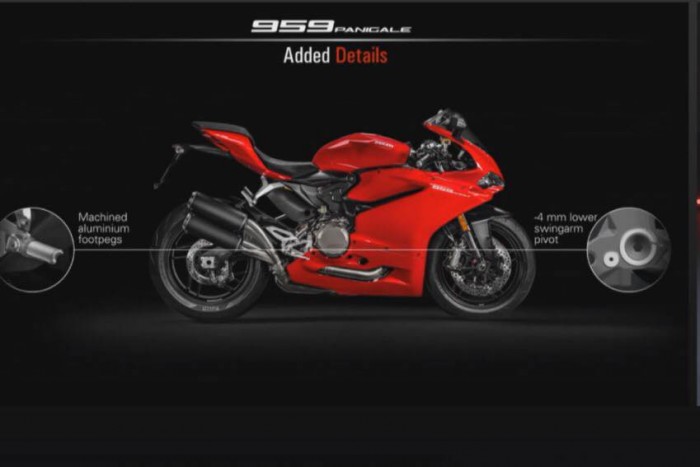

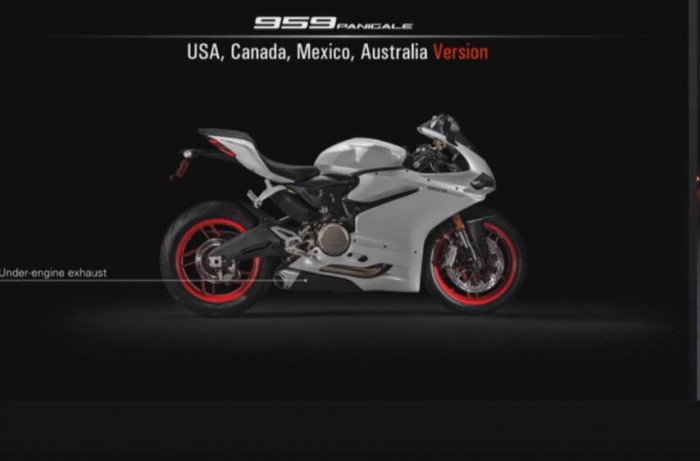

Click here for Ducati 959 Panigale Performance Parts & Accessories
- Published in Motorcycles
New 2016 Ducati Scrambler Flat Track Pro
New 2016 Ducati Scrambler Flat Track Pro
Ducati Scrambler Flat Track Pro is designed as a speeding machine. It features dedicated livery, fuel tank in racing yellow, aluminium rear view mirrors, sporty headlight fairing, alloys with yellow outlines, CNC footpegs, CNC sprocket cover, full throttle exhaust, dedicated number plate, dedicated seat fabric, etc.
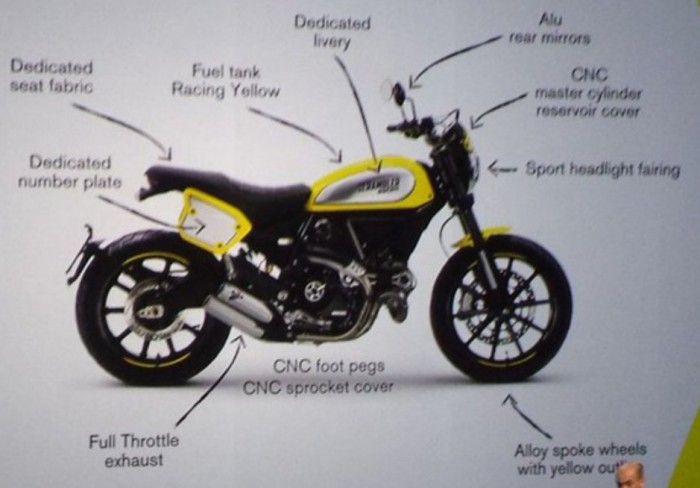
More details will be revealed soon. Stay tuned.
Click here for Ducati Scrambler Parts & Accessories
- Published in Motorcycles
New 2016 Ducati Scrambler Sixty2
New 2016 Ducati Scrambler Sixty2
Ducati has officially taken wraps off the new Scrambler variants, one of them is the much awaited 400 cc entry level variant.
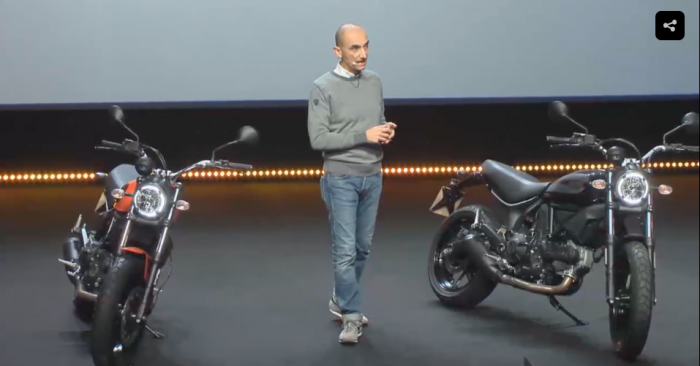
At the EICMA (Esposizione Internazionale Ciclo Motociclo e Accessori), also known as the Milan Motorcycle Show in Italy, Ducati unveiled a total of seven new bikes. Two of them are Scrambler variants – Sixty2 and Flat Track Pro.
Of the two, Ducati Scrambler Sixty2 is powered by a new 399 cc single cylinder desmodromic air cooled engine. This engine generates a peak power of 41 hp. Not much is known, except that this entry level Ducati gets Showa 41 mm front forks in the front, steel tube swingarm at the rear, has a 14 litter steel fuel tank with dedicated logo, dry weight of 167 kg, and a new black silencer cover.
Click here to view Ducati Scrambler parts
- Published in Motorcycles
MV Agusta F4 RC First Test Ride Review
MV Agusta F4 RC First Test Ride Review
We’ve nailed a real beauty here – The first ride of an MV Agusta F4 RC by anyone outside of MV itself. At least, we are as far as we can gather media-wise, which can’t be a bad effort, can it? Yep, we got our hands on one before anyone else, anywhere. Us FB cats have truly had our cream…
So, let’s see – 212bhp, 111Nm of torque, 175kg, the finest carbon fibre and suspension known to man, and looks to die for? Bring it on! What do we think of it? Well, the full test you can read in a future magazine (issue 303 out on June 23rd), but we’re happy to tease with a few thoughts on the most incredible F4 MV have ever produced. Thus, here are five observations on this little beauty.
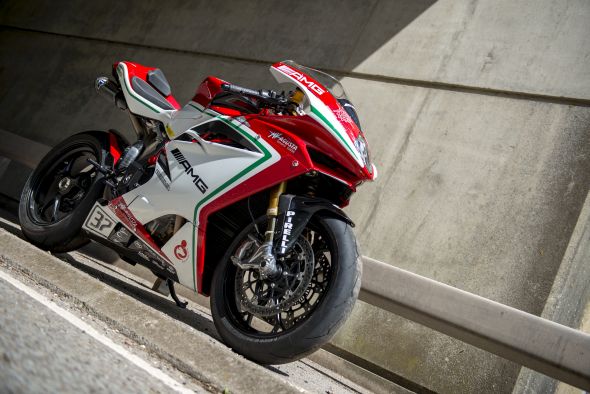
1 – It is unbelievably, jaw-droppingly gorgeous to behold – Okay, this is probably the easiest thing you could work out for yourselves, but even we were stopped dead in our tracks when we met it for the first time. The attention to detail is fantastic, build-quality has surpassed other current versions of the F4 (which was already top notch), and it really does merit its staggering asking price of a pound shy of £31,000 on looks and detail alone. This one had just begun the tentative transformational first steps into becoming a race bike, so had the achingly delicious full Termignoni titanium full-system fitted, as well as a few of the bits and pieces that come in the carbon-fibre race-pack box. Even the simple yet stunning rearsets are there to be admired, and the carbon fibre fairings are boss. It really is wondrous.
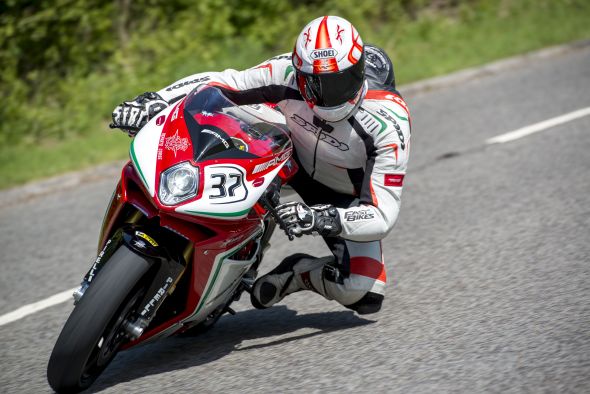
2 – It’s rather fast – With a claimed 212bhp (crank figure), you wouldn’t expect it to be slow and it certainly isn’t, oh no… The RC is surprisingly usable for what’s essentially a WSB machine on the road, but it’s when the tacho rises that you get your real kicks. And it’s further up the rev scale that it really impresses. When you’d expect it to start tailing off, it kicks in again hard like a steel-capped boot up the jacksie, screaming through those beautiful open pipes a rapturous cacophony that demanded anybody within a mile turned around and took notice. As eye-ball widening rides go, this is one that makes you go “Ooooh, shiii….”
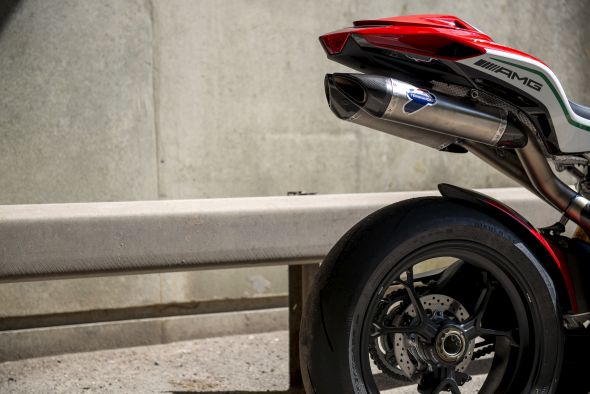
3 – You can really feel the weight loss – The RC is a solid handling bike, pukka geometry and Öhlins’ finest ensure that, but it’s the diet notching it down to 175kg that really shines through. The latest F4s all handle really well, but this one adds a previously missing flickability to the solid cornering skills. Chuck in a wonderfully intuitive riding position allied to super responsive input ratios, and you have a bike you’d happy ride on road or track every day for the rest of your life.
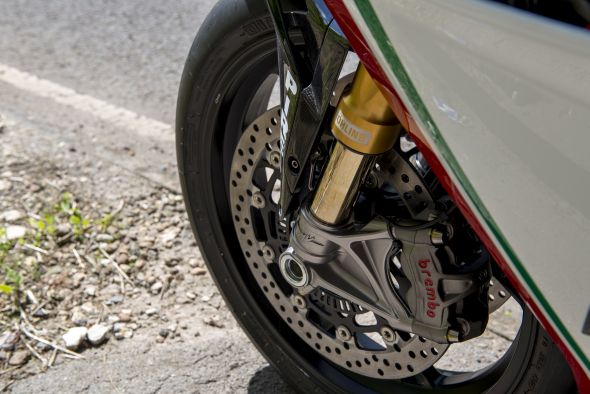
4 – It’s got real character – Traditionally firing inline four cylinder machines suffer from a slight lack of character during these days of cross-pane cranks, V4s, blaring triples and huge thumping twins. Not the RC, it lives and breathes, kicks and screams in a way a Suzuki GSX-R or Honda Fireblade can only dream of. Even the bolshy BMW S 1000 RR, while bonkers, is a dweeb sat alone in the corner of the wine bar, compared to the RC which is making every woman under the roof swoon, while arm-wrestling anyone who fancies being humiliated by the smartly dressed, dashing cad. You drink in its essence sat onboard, it talks to you, flatters you just by sitting on it – it’s an overwhelmingly incredible experience. It doesn’t even sound like any other inline four around, it rocks to its own beat, and that beat is terribly catchy.
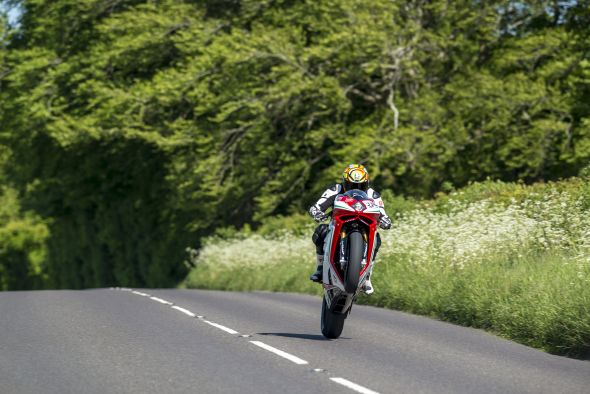
5 – They’re all sold out – At least, we think they are, there may be one or two somewhere around the globe but you’d better be bloody quick if you just happened to find £31k behind the fridge and want one. And, why wouldn’t you?! Otherwise you’ll have to wait until one comes up for sale, which could be a while. Only 250 are being made and a lot of those will end up on race tracks, like this one from Hampshire MV will at a BSB circuit near you soon. The rest will go to MV aficionados, collectors and those lucky (read – rich) enough to snap one up. Nope, we don’t like them any more than you do! 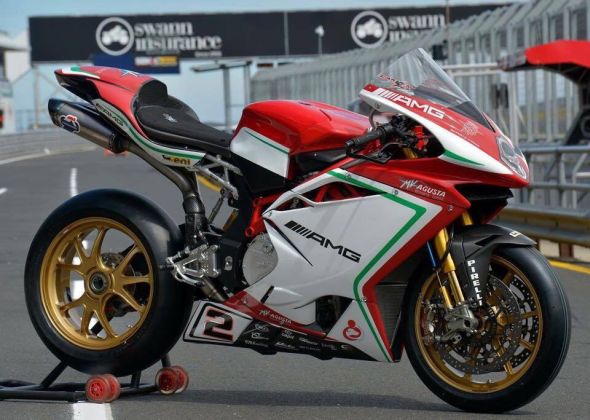
Click on the link below to view MV Agusta parts
Source: Fastbikesmag
- Published in Motorcycle Review
Ducati Monster 1200R First Ride Review
Ducati Monster 1200R First Ride Review
The letter R is sacred to Ducati. Should a Ducati come with an R at the end of its title, you know you’re in for something a bit spesh. Ducati doesn’t just throw the R around like dollar bills on a Saturday night. Panigale R, 1098 R, 996 R, these bikes have earned their place in the pantheon of special Ducatis.
Until now, the R moniker was limited only to track-ready weapons, but the super naked class has dawned full of machines that would wipe the floor with superbikes from not so long ago, and has spurned the Bologna boys into creating this, the Ducati Monster 1200 R – the most powerful nakedbike ever to come from Italy’s Borgo Panigale region.
This is the second new Monster in two years. The original Monster 1200 S missed the mark, judged as being too much road and not enough track against circuit derived bikes like the BMW S 1000 R and Aprilia Tuono – the 1200 R goes some way to rectifying this. Ducati is aiming this machine at the fast canyon, occasional trackday rider, the guy that knows what he’s doing in either circumstances but doesn’t need a Panigale to do it.
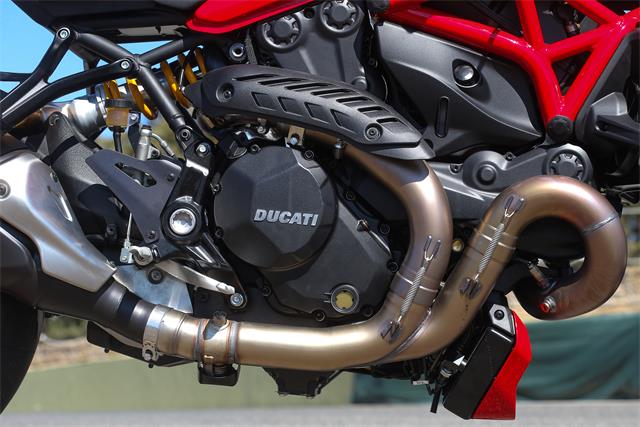
More compression, bigger throttle bodies and a new exhaust have boosted the power to a claimed 160hp.
Compared to the 1200 S, Ducati has upped the 1200 R’s 11° Teststretta’s power 15hp to a claimed 160hp at 9250rpm and increased torque by a claimed 6Nm to 97lb-ft at 7750rpm via new 56mm throttle bodies (up from 53mm), increased compression from 12.5:1 to 13:1 and increased exhaust header diameter a whopping 8mm to 58mm, matching the lot to a revamped but more aesthetically pleasing double barrel muffler. The new exhaust helps bring the 1200 R’s engine in line with Euro 4 emissions requirements, a target every new bike will now be required to meet.
The engine improvements are met with chassis details that have transformed the Monster’s handling from a machine that was out of its depths on the track to one that’ll ham trackdays with the best nakeds out there. Gorgeous black Öhlins forks grace the front – a rarity for any production bike as Öhlins, like we all know, come in gold – matched to an Öhlins rear that has helped raise the bike by 15mm. The new suspension doesn’t give the front any more travel, which is kept at the 1200S’s 130mm, but the rear now gets an extra 7mm of travel to 159mm. There’s also a nice little Öhlins steering damper mounted on the top triple clamp staring you in the face if you happen to like wheelies – which the 1200 R is very, very good at.
Perhaps most telling of all is Ducati’s decision to fit a 200-section rear tire over the 1200 S’s 190 fitted to Marchesini forged aluminum wheels. This little bit of extra tire, combined with more rear wheel travel and ground clearance, means Ducati is claiming 50° lean angle with the Monster 1200 R – who’d have thought only a few years ago we’d even care what lean angle the Monster would get?
Topping the list of changes off are new race-style footpegs (not rearsets, they’re still on a spring), a slightly forward biased riding position and styling updates that include that delectable rear seat unit design that’s now almost devoid of clutter between the number plate and wheel, new side radiator guards embossed with the all important “R” and red stitching down the side of the seat (the passenger’s half of the seat hides under a flimsily-secured cover that doesn’t match the R tag or price of the machine).
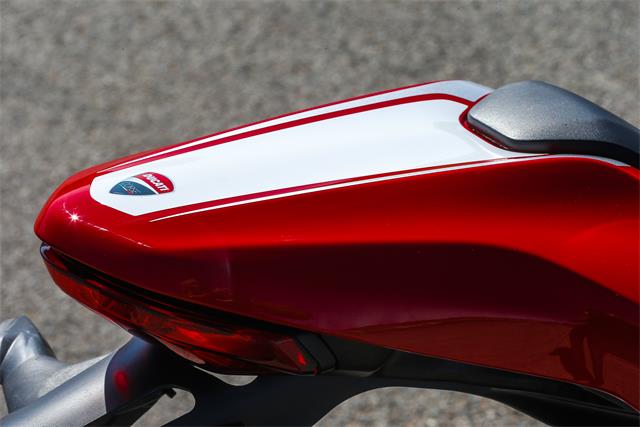
Ducati has worked hard to give the Monster R a racy-looking bum.
The chance to explore these new improvements to the Ducati Monster 1200 R came at God’s Own Racetrack, Ascari, about a two hour drive from Malaga in southern Spain. When I die, provided I’ve been a good boy, this is where I’m headed. This is one of the finest ribbons of racetrack on the face of the planet, a private paradise of speed with every imaginable corner and bend and nip and tuck you’d ever want to ride. Now, I’ll admit here it was a shame not to take the 1200 R on some of nearby Rhonda’s mountainous bends, but that’s they way it is, so we’ll have do with Ascari and a track only comparison. What a shame…
But Ascari is probably the closest track I can think of with corners that we’d experience here in the States – big style canyon sweepers, tight off-camber decreasing radius down hill passes and speed days.
Back when I last tested the 1200 S Monster in Australia last year, I surprised myself by saying this was the first time I’d ridden a bike that I preferred to keep in Touring rather than the full Sport mode. The throttle was too abrupt, too snatchy in Sport, so it was good to see those larger throttle bodies and increased compression has made the Monster much more tractable off the bottom of the throttle. Rather than being met with a punch in the face when you snap the throttle open, now you get smooth, strong drive that’s not only easier to modulate but doesn’t upset the chassis as much on the side of the tire. The 1200 R’s claimed extra 15hp are one thing, but I’ll trade them for a nicer throttle than the 1200 S’s. Happily, you don’t have to. You get both!
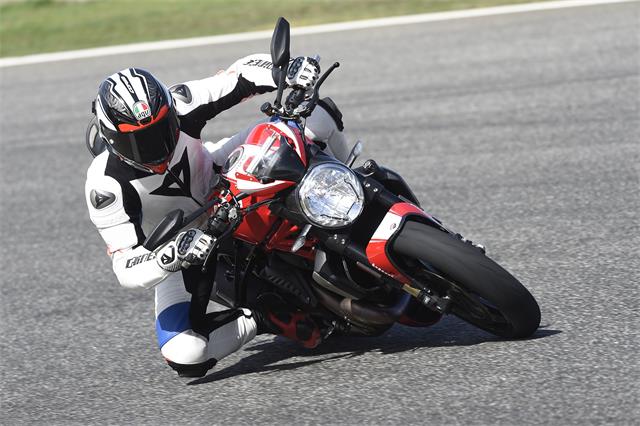
More ground clearance makes track riding much more fun than on a 1200 S.
The slightly increased compression has given the Monster extra hair on its chest through the midrange, with a touch more top-end grunt when you’re really going for it. Snap that throttle open anywhere from 5-8000rpm and you’ll get plenty of DTC (Ducati Traction Control) inducing grunt as you let the electronics take over. Bring on the hate mail if you will, but traction control is now so good you can slam the throttle open at points of the corner that would otherwise send you on a one way ticket to the moon.
But one of the big omissions, especially considering the price of the 1200 R relative to the competition, is the lack of a quickshifter. Considering it’s now at the top of the money pile, I’d have liked the R to come with one as the gearshift is not the smoothest I’ve sampled recently. It’s by no means bad, but its omission from standard equipment is a mark against the bike.
The extra torque means a more flexible desmo, an engine that’s now got hardly any weak spots. Smooth initial throttle, plenty of midrange torque for corner-to-corner zipping and a bit more up top – happy days. But that’s not the most impressive thing about the 1200 R, that honor goes to the chassis.
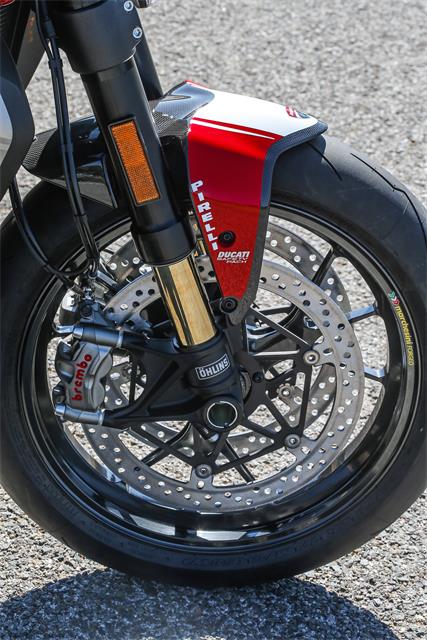
Gorgeous black Öhlins hint at the R being the special one…
The issue with the 1200 S was never the engine. Yes it’s nice to have the aforementioned improvements, but where the S lacked was its sluggish, heavy steering and limited ground clearance that would have you dragging the pegs way too early in a corner. The 1200 R has gone a long way to correcting this and now steers with the precision the S should have had all along. The extra 15mm of height thanks to the revamped front and rear Öhlins means you can be a lot more aggressive on corner entry, throwing the Monster from side to side easily without feeling like you’re riding a grinder. The wider 200-section rear tire gives the 1200 R a sure-footed feel in the middle and exit of the corner – it’s interesting that Ducati has made the 1200 R steer better with a wider rear tire than the 190-section used on 1200 S.
The Monster has always been styled by the shape of the tank. Cast your mind back to any Ducati other than one that starts with the letter M and you will not see another tank like it, so this was something chief designer Gianandrea Fabbro tried very hard to maintain the looks of. The new 1200 R’s tank is a touch more svelte than the S’s but it’s got deeper knee indents to allow a better tuck on the track. This, combined with the slightly more forward-mounted and higher bars gives the 1200 R a bit more of a motard feel, giving you more room to move and making the chassis more maneuverable in corners.
We were spoiled a touch at Ascari as we had Ducati test rider Alessandro Valia set the clickers for us for the morning and afternoon sessions, so the Monster was pretty much as good as it could be with stock suspension, so we’ll have to wait until we get a road test unit to see how it handles on anything other than billiard smooth tarmac with settings picked by the Ducati test rider…
So now we come to the $18K question – is the new Monster now top dog in the super naked category. The answer, simply, is no. Having just completed our super naked shootout a couple of weeks ago, I can safely say it wouldn’t knock the Aprilia off its perch as the reigning king. But that’s not to say it is not a great bike, because the Monster 1200 R is far better than the 1200 S it now stands in front of on the spec sheet (not replaced, you can still buy the S), and it’s not a race derived bike like the top two that finished up in our comparo test. There are parts of the Monster that are disappointing – no quickshifter, that seat cover, and electronics that are annoying to change base settings on, like the KTM) – but these are off-set by the deft touch of the traction control system, the beautiful swooping lines of the tank and those oh-so-sweet black Öhlins forks. And it has become a very handy track machine.
Ducati has done exactly as they planned with the 1200 R – keep the road-based traditions of the 21-year-old Monster lineage but upgrade the bike to such a level that it’s no longer out of its depths on the track. I have no doubt this will make an excellent road weapon (that extra ground clearance especially will work wonders when hitting potholes), and the Monster has something not one of the leading nakedbikes have – that inimitable Ducati style – which on itself will bring buyers to dealer floors.
The price is right up there, but you’re getting a very good bike for the money.
Click here to view our Ducati Monster 1200 performance parts & carbon fibre
source: cyclenews.com
PHOTOGRAPHY BY DUCATI MOTOR
- Published in Motorcycle Review
2016 Triumph Thruxton Racer
2016 Triumph Thruxton and Thruxton R first pics of all-new models! 64% more torque and killer 1960s looks!
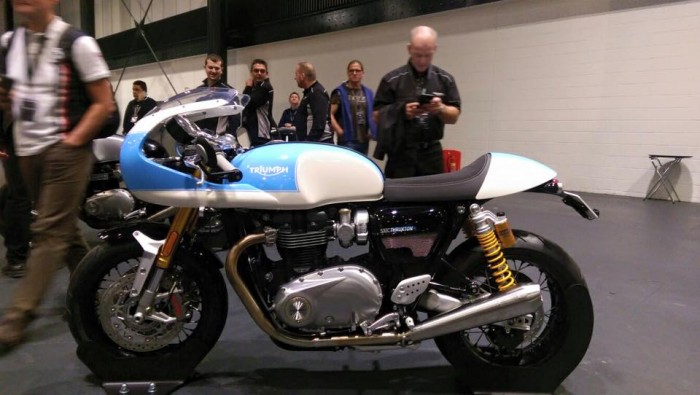
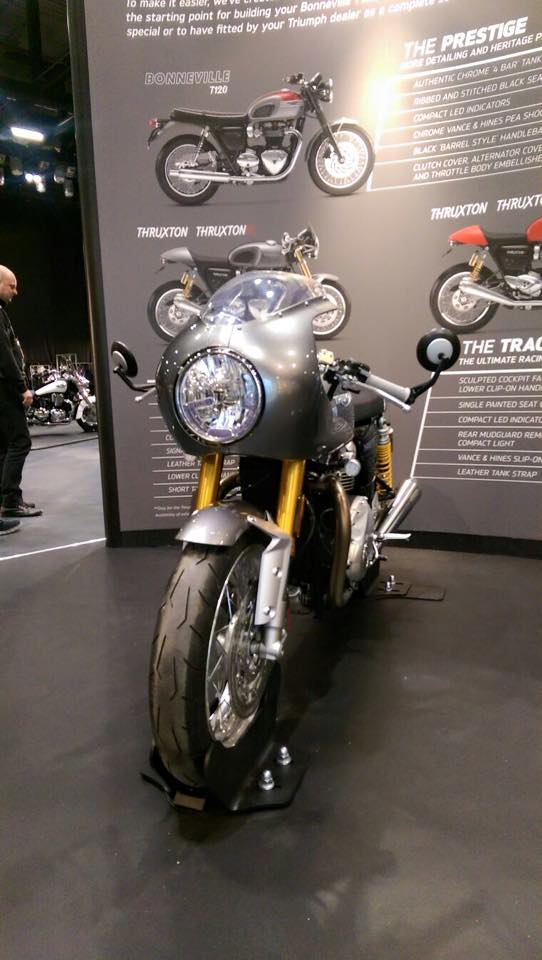
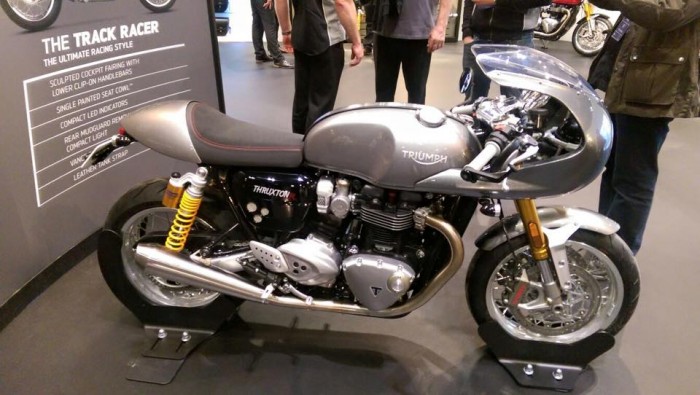
Triumph has launched the new Thruxton and Thruxton R as part of the 2016 Bonneville range, which also includes the brand new Street Twin and the upgraded T120 and T120 Black.
The Thruxton is the bike that was featured in the recent Outlaws film starring David Beckham. It is edgier and sportier than the other models in the new range. So if you wanted something racier than the T120 or more powerful than the Street Twin then here’s your answer: the new Thruxton and Thruxton R.
The new Thruxton builds on the rich heritage of Triumph bikes named after the legendary 500-mile Thruxton endurance race series. Back in the day, it was the Triumphs that dominated it, and also broke the first 100mph lap at the Isle of Man TT. No wonder then that the Bonneville Thruxton racers inspired a generation of teenage café racers and custom special builders.
The new Thruxton and Thruxton R for 2016 are striking machines. They combine the classic racer look with modern touches, and seeing them in the flesh, it takes some self-control not to jump on one and break for freedom. Trust me, the photos don’t do them justice. The bikes simply ooze style, elegance and a slightly unnerving promise of raw power.
Engine
Triumph describes the other engines in the new Bonneville line-up as ‘high torque’. They refer to the Thruxton engine as ‘high power’. And that’s the clue if anyone needed it; this is a full-blooded modern-day café racer, a sports classic built for speed and power as much as looking uber-cool outside the Ace café.
The 1200cc, eight-valve, parallel twin engine that powers both the Thruxton and Thruxton R delivers a claimed peak torque figure of 112Nm at 4,950rpm – a whopping 62% more than the previous generation 865cc engine (69Nm at 5,800rpm). Triumph has not confirmed the bhp details yet, but with the increase in engine size, this should go up quite nicely too.
As with the T120 bikes and the Street Twin, the new Thruxton engine is liquid-cooled to meet the new Euro4 emissions requirements. The cutting-edge liquid cooling system has been carefully integrated to minimise its visual impact – it looks the part. It also enhances fuel efficiency, which is never a bad thing.
The six-speed engine features a lighter crank, higher compression and a unique airbox. Triumph’s next generation ride-by-wire fuel-injection is fed by authentically styled twin throttle bodies that take nothing away from the classic looks of the bike.
The twin upswept exhausts have reverse-megaphone end cans that deliver a beautiful, rich exhaust note to match the bike’s looks. The pipes are finished in chrome on the Thruxton and brushed stainless steel on the Thruxton R.
Handling
Both the Thruxton and Thruxton R have new chassis and suspension, and according to Triumph this is all about sharp handling that really delivers on its café racer looks. Sitting on the bike, the riding position is surprisingly pleasant and natural, despite the low bars and the racer looks. Apparently this is 100% intentional. We haven’t had a chance to ride the bikes yet, but as soon as we do, we’ll let you know exactly what they’re like on the road (or track for that matter).
The bikes have sporting ergonomics, clip-on bars, fully adjustable suspension and 17-inch front wheel – all to ensure good handling and agility and, of course, a thrilling ride.
The Thruxton R is an upgraded version of the Thruxton with twin floating Brembo discs, racing Brembo monobloc callipers, Brembo master cylinder, race-bred, fully-adjustable Showa big piston forks, fully-adjustable Öhlins twin rear shocks and Pirelli Diablo Rosso Corsa tyres.
The new Thruxton and Thruxton R may look like classic racers but they feature a full suite of rider-focused technology, as Triumph puts it “sensitively integrated and without compromise to maintain its authentic Bonneville style and character”.
The modern technology that the Thruxton and Thruxton R come with includes variable anti-lock braking system (ABS), ride-by-wire throttle, traction control, slip-assist clutch and three rider modes (rain, road and sport).
There’s also LED lights, USB socket and stylish twin clocks, controlled by elegant and simple switchgear.
Style
Even without resorting to the accessories that Triumph offers, the Thruxton and Thruxton R have all the styling elements of modern café racers covered.
Both bikes have a ‘flip-top’ Monza-style fuel cap (a first on any modern production bike, according to Triumph), bullet seat and lightweight aluminium bar-end mirrors, wheel rims and swinging arm. The Thruxton R also features an additional painted seat cowl, polished top yoke, aluminium tank strap and clear anodised aluminium swinging arm.
What is striking about these bikes is the level of detail and the high-quality finish that is evident in all components. Everything from the flawless twin-skinned pipes to the elegant badges breathes elegance. And little touches, such as the red spark plug cover show that everything has been thought through to create both a high-performing and a highly-cultured machine.
The Thruxton comes in three colour choices:
– Jet Black
– Pure White, with a black tank stripe
– Competition Green, with a metallic gold tank stripe.
The Thruxton R comes in two colour choices:
– Diablo Red
– Silver Ice.
Customising the Thruxton and Thruxton R
Triumph has seen potential in the growing trend of custom bikes and these new Bonnies come with a host of factory accessories, 160 for the Thruxton and Thruxton R alone, to be precise. The range covers everything from sculpted cockpit fairing and exhausts from Vance & Hines to bullet indicators and lower clip-on handlebars.
There are also three ‘inspiration kits’ that can be fitted at the dealers or in your own garage to instantly change the look of the bike. The options available for the Thruxton models are:
The Track Racer inspiration kit
The Track Racer kit features a host of competition-inspired accessories, including:
– Sculpted cockpit fairing with lower clip-on handlebars
– Single painted seat cowl (only for the Thruxton as already standard on Thruxton R)
– Rear mudguard removal kit with compact light
– Compact LED Indicators
– Vance & Hines slip-on silencers
– Knurled handlebar grips
– Leather tank strap.
The Café Racer inspiration kit
Bringing the full-on café racer style to the Thruxton and Thruxton R, including:
– Rear mudguard removal kit with compact light
– Vance & Hines exhausts
– Lower clip-on handlebars
– Short tinted fly-screen
– Compact LED indicators
– Single painted seat cowl (only for the Thruxton as standard already on Thruxton R)
– Signature Triumph rubber knee pads
– Knurled handlebar grips
– Leather tank strap.
Performance race kit for the Thruxton R In 2016 Triumph will launch a unique Triumph race kit only for the Thruxton R, that’s been specifically designed and developed for competition use and closed-circuit racing. The Factory Race kit will take the standard engine performance to an even higher level, with more power and torque, and lower overall weight.
source: morebikes
- Published in Motorcycles




